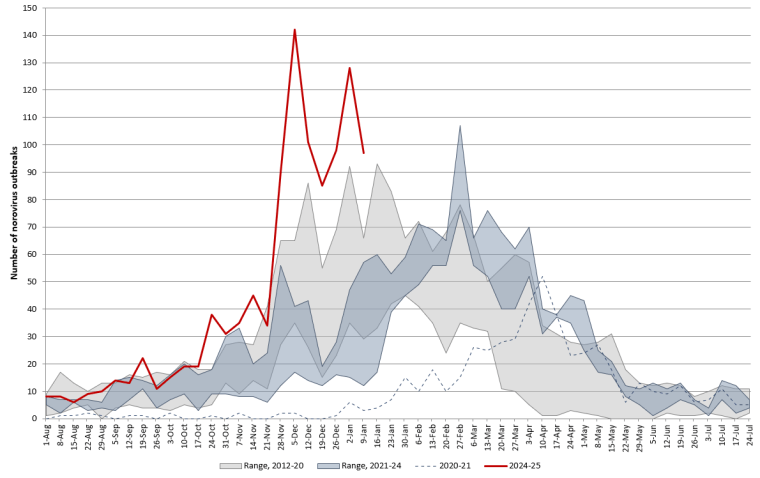Cases of norovirus, also known as the stomach flu, are still surging across the United States. The highly contagious gastrointestinal bug, which causes sudden and miserable bouts of vomiting and diarrhea, is causing a record number of outbreaks for this time of year.
There were 97 suspected and confirmed norovirus outbreaks reported in the U.S. during the week ending Jan. 9 and at least 128 outbreaks the week prior — more than double the number of outbreaks recorded during the same period over the last three years, according to the latest data from the U.S. Centers for Disease Control and Prevention.
In fact, norovirus outbreaks in the U.S. in early January reached the highest level for this time of year since 2012, CDC data show.
“This year, the number of reported norovirus outbreaks have exceeded the numbers that we’ve seen recently and in the years before the pandemic,” a CDC spokesperson tells TODAY.com.
Experts are warning that significant norovirus activity is expected to continue in the coming weeks, and that a popular hygiene method — using hand sanitizer — is not effective against the virus. Instead, it’s best to wash your hands properly and often.
Norovirus is technically a group of viruses, which are the leading cause of acute gastroenteritis, or an inflammation of the stomach and intestines that leads to vomiting, diarrhea and stomach cramps. Although its nickname is the "stomach flu," norovirus is not related to influenza viruses, which cause respiratory illness.
Norovirus spreads through contact with sick people or via contaminated food, drinks or surfaces. Outbreaks are notoriously fast-spreading and tough to control. The virus can spread rapidly through homes, schools, day cares, and other community settings.
In the U.S., norovirus causes an average of 19–21 million illnesses, 109,000 hospitalizations and 900 deaths annually, per the CDC.
Norovirus outbreaks 2025
Each year, about 2,500 norovirus outbreaks are reported in the U.S., per the CDC. These can occur throughout the year but are most common between November and April.
“It’s also called the winter vomiting disease, which emphasizes the seasonality of norovirus. It can occur during the summer, but it really does increase in the winter,” Dr. William Schaffner, professor of infectious diseases at Vanderbilt University Medical Center, tells TODAY.com.
It’s not surprising to see an uptick in norovirus cases this time of year. However, the latest increase is “quite substantial,” says Schaffner. In recent weeks, norovirus has climbed to decade-high levels.
“The total number of outbreaks reported during this 2024–2025 season is above those reported during the same period during 2012–2020 and 2021-2024,” the CDC spokesperson says.

From Aug. 1, 2024 to Jan. 15 2025, there were 1,078 norovirus outbreaks reported by the 14 states participating in the CDC’s NoroSTAT surveillance program. During the same period in 2023, 557 norovirus outbreaks were reported from these states.
Additionally, the percentage of norovirus tests coming back positive is rising. According to data from labs across the U.S. reporting to the CDC, the average norovirus test positivity rate was 23% for the week ending Jan. 18. During the same week last year, around 12% of norovirus tests were coming back positive.
Wastewater surveillance, which serves as an early warning sign that cases are rising in a community, is also showing an increase.
According to WastewaterSCAN — a program that monitors viruses through municipal water systems led by scientists at Stanford and Emory University — norovirus levels are still "high" nationwide.
“Norovirus levels are rising all across the country, and in the 'high' category in all regions,” Marlene Wolfe, Ph.D., assistant professor at Emory University and principal investigator of WastewaterSCAN, tells TODAY.com.
“We expect to see norovirus increasing at this time of year, (and) our data do suggest that the current levels are higher than previous years,” says Wolfe.
What's more, the dreaded stomach bug is surging on cruises. Since December, there have been at least nine norovirus outbreaks on cruise ships under U.S. jurisdiction, which sickened more than 1,250 people total, CDC data show.
Why is norovirus surging?
Norovirus outbreaks tend to peak in the U.S. during the cooler winter months, when more people are crowded indoors. The holidays often tend to lead to more transmission, experts say.
“Gathering together, especially this time of the year, and all the traveling we’re doing is causing the increase,” NBC News medical correspondent Dr. John Torres said in a TODAY segment aired Dec. 31.
The fast-moving virus spreads easily between people, especially in enclosed spaces, says Schaffner. It affects people of all ages.
There are several strains of norovirus that infect humans, but these can mutate rapidly. "Circulating strains change over time, and this can affect disease burden," the CDC spokesperson says.
In years where there is a new strain of the virus, there can be 50% more norovirus illness, according to the CDC.
"I haven't heard anything yet about current strains and whether they're remarkably different than the ones that were causing illness two, three, four years ago — but you have to wonder," says Schaffner.
It isn’t clear how the rest of the winter will pan out, Schaffner adds. However, norovirus is expected to keep spreading in the coming months.
“We can’t predict the future with wastewater data, but norovirus usually peaks between February and April," says Wolfe. In previous years, significant norovirus activity has continued as late as May.
"The levels of norovirus in wastewater are already quite high — it remains to be seen if we will have an earlier peak this year, or whether these levels will continue to rise," Wolfe adds.
The CDC is continuing to conduct surveillance for outbreaks and monitor norovirus strains, the spokesperson says.
Norovirus symptoms
Norovirus symptoms typically begin 12 to 48 hours after exposure to the virus, per the CDC. These are often sudden and "explosive," says Schaffner.
Common norovirus symptoms include:
- Diarrhea
- Vomiting
- Abdominal pain or cramps
- Nausea
People often vomit or have diarrhea many times, and these can happen simultaneously, says Schaffner.
Less commonly, people may experience a low-grade fever or chills, fatigue and body aches, according to the Cleveland Clinic.
How long does norovirus last?
Norovirus symptoms typically last one to three days, and most people will recover on their own completely. “People get over this after a few days of being miserable,” says Schaffner.
Is norovirus deadly?
In most cases, norovirus is not life-threatening and deaths are rare, especially in the U.S. However, it can cause severe disease and complications. “The concern is always dehydration because of the fluid loss through vomiting and through diarrhea," says Schaffner.
The people at highest risk of severe illness include young children, older adults, and people who have compromised immune systems or underlying conditions such as diabetes or heart disease, Schaffner notes.
Signs of dehydration include decreased urination, dry mouth or dizziness, per the Mayo Clinic. Children may cry without tears, have dry lips or sunken eyes, and become fussy or lethargic, TODAY.com previously reported.
How does norovirus spread?
Norovirus spreads between people very easily. "It’s an extraordinarily communicable, transmissible virus," says Schaffner.
Once infected, a person can shed billions of norovirus particles in their vomit and stool. “It takes a very small number of (particles) to initiate an infection,” says Schaffer. People become infected when these virus particles accidentally end up in their mouths.
Transmission of norovirus may occur through:
- Direct contact with a sick person
- Sharing food or utensils with a sick person
- Consuming food or drinks contaminated with the virus
- Touching contaminated surfaces then touching your mouth
- Inhaling aerosols from a sick person's vomit
Most outbreaks of norovirus happen when infected individuals spread the virus to other people through close contact, per the CDC. Common settings for norovirus outbreaks include schools, day cares, cruise ships, nursing homes and health care facilities.
The virus particles can live for extended periods on surfaces such as doorknobs, toilet handles, sinks and counters, which makes it easy to spread through indirect contact as well.
Norovirus is also the leading cause of foodborne illness in the U.S., per the CDC. “Norovirus can contaminate many foods, particularly foods that aren't cooked,” says Schaffner. These include raw shellfish, particularly oysters and clams, which can become contaminated when they filter-feed polluted water, NBC News previously reported.
How long is norovirus contagious?
Norovirus is contagious from the moment symptoms begin until at least a few days after symptoms resolve. People infected with norovirus can shed the virus in their stool even after they recover, says Schaffner. It's possible to spread norovirus to others for two weeks or more after you feel better, per the CDC.
These microscopic norovirus particles, invisible to the naked eye, can linger on surfaces and objects for weeks.
What's more, alcohol-based hand sanitizers and cleaners do not work against norovirus. Norovirus particles are especially hardy and difficult to kill thanks to their firm outer shell, says Schaffner. It's important to wash your hands with soap and water for 20 seconds or clean with bleach-based solutions instead, per the CDC.
Norovirus immunity
Infection with norovirus is thought to provide some immunity, says Schaffner, but it's unclear how long this lasts. It's likely short-lived. There are multiple types of norovirus, so infection with one may not protect against other types, per the CDC. People may be reinfected with norovirus many times in their lives.
Norovirus treatment
There's no specific antiviral treatment for norovirus, says Schaffner.
Norovirus will typically resolve on its own, but rest and supportive care can help manage symptoms. Rehydration is key, Schaffner notes. Drinking water, sports drinks and oral rehydration solutions can help replenish fluids lost during diarrhea and vomiting.
“Most people recover with home care and many do not need to see a healthcare provider,” says Wolfe.
High-risk individuals or people with severe disease may require additional care, such as intravenous fluids, says Schaffner.
If norovirus symptoms become severe, persist or worsen after a few days, or you can't keep fluids down, seek medical attention.
How to prevent norovirus
There is no vaccine available against norovirus, says Schaffner, but research to develop one is ongoing.
In the meantime, you can take the following actions to protect yourself and others against norovirus, according to experts:
- Wash your hands often.
- Cook shellfish thoroughly.
- Stay home when sick.
- Avoid cooking for others while sick.
- Disinfect contaminated surfaces with a bleach solution.
- Launder soiled bedding or clothes on high heat.










